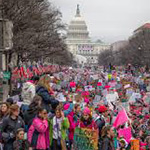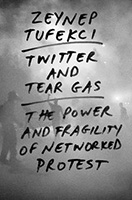 |
The power of social media to build alliances with like-minded people and organize protests is unquestioned.
But as the book, “Twitter and Tear Gas: The Power and Fragility of Networked Protest,” written by Turkish “techno-sociologist” Zeynep Tufekci points out, the initial moment of a movement bursting onto the scene should be viewed as only the first step.
She wrote that the failure to generate reforms in the Middle East following the Arab Spring protests may have been due to how easy it was to get people out into the streets.
Organizers were gobsmacked by the number of protestors but lacked the follow-through and hard work required in the aftermath of the demonstrations to achieve political change.
They fell into the trap of believing the Arab Spring was the culmination of an organizing campaign, rather than just the beginning.
In contrast to the Arab Spring, Tufekci wrote that civil rights activists in the US spent years planning the Montgomery bus boycott in 1955 and March on Washington in 1963.
 |
David Cole, ACLU legal director, wrote in his review of "Twitter and Tear Gas" that civil rights activists “had to work for years to develop the networks, relationships, organizations and leaders necessary to sustain the boycott and carry out the march.”
Major demonstrations of today can be launched in a matter of weeks, thanks to social media. “It took less than six weeks after the Parkland shootings in February 2018 to mobilize more than one million people nationwide for the March for Our Lives,” wrote Cole. “The Women’s March, the most impressive anti-inaugural protest in history, was put together in a little more than two months.”
A mass protest is now a less meaningful indicator of a movement’s influence, noted Cole.
He believes the jury remains out on whether the March for Our Lives and Women’s March will achieve lasting reform. It will depend on those movements “working collectively in multiple forums, including courtrooms, state legislatures, corporate boardrooms, union halls and most importantly at the ballot box,” wrote Cole in the Feb. 7 New York Review of Books.
His recommendation: “We all need to turn away from our smartphones and screens and engage, together, in the work of democracy.”


 The NBA, which promotes legalized gambling 24/7, seems more than hypocritical for banning player for placing bets... Diocese of Brooklyn promises to issue press release the next time one of its priests is charged with sexual abuse... Truth Social aspires to be one of Donald Trump's iconic American brands, just like Trump University or Trump Steaks or Trump Ice Cubes.
The NBA, which promotes legalized gambling 24/7, seems more than hypocritical for banning player for placing bets... Diocese of Brooklyn promises to issue press release the next time one of its priests is charged with sexual abuse... Truth Social aspires to be one of Donald Trump's iconic American brands, just like Trump University or Trump Steaks or Trump Ice Cubes. Publicis Groupe CEO Arthur Sadoun puts competition on notice... Macy's throws in the towel as it appoints two directors nominated by its unwanted suitor... The Profile in Wimpery Award goes to the Ford Presidential Foundation for stiffing American hero and former Wyoming Congresswoman Liz Cheney.
Publicis Groupe CEO Arthur Sadoun puts competition on notice... Macy's throws in the towel as it appoints two directors nominated by its unwanted suitor... The Profile in Wimpery Award goes to the Ford Presidential Foundation for stiffing American hero and former Wyoming Congresswoman Liz Cheney. JPMorgan Chase chief Jamie Dimon's "letter to shareholders" is a must-read for PR people and others interested in fixing America and living up to its potential... Get ready for the PPE shortage when the next pandemic hits... Nixing Netanyahu. Gaza carnage turns US opinion against Israel's prime minister.
JPMorgan Chase chief Jamie Dimon's "letter to shareholders" is a must-read for PR people and others interested in fixing America and living up to its potential... Get ready for the PPE shortage when the next pandemic hits... Nixing Netanyahu. Gaza carnage turns US opinion against Israel's prime minister. Trump Media & Technology Group sees Elon Musk's X as an option for those who want the free expression promised by Truth Social but without Donald Trump, owner of 57.3 percent of TMTG... Chalk one up for "anti-woke warrior" governor Greg Abbott as University of Texas lays off 60 DEI-related staffers... Five percent of Americans see the US as its own worst enemy, according to Gallup.
Trump Media & Technology Group sees Elon Musk's X as an option for those who want the free expression promised by Truth Social but without Donald Trump, owner of 57.3 percent of TMTG... Chalk one up for "anti-woke warrior" governor Greg Abbott as University of Texas lays off 60 DEI-related staffers... Five percent of Americans see the US as its own worst enemy, according to Gallup. Nine of the Top 100 firms that participated in O'Dwyer's rankings last year apparently threw in the towel for the 2024 scorecard. Seven other firms also went AWOL.
Nine of the Top 100 firms that participated in O'Dwyer's rankings last year apparently threw in the towel for the 2024 scorecard. Seven other firms also went AWOL.


 Have a comment? Send it to
Have a comment? Send it to 
No comments have been submitted for this story yet.